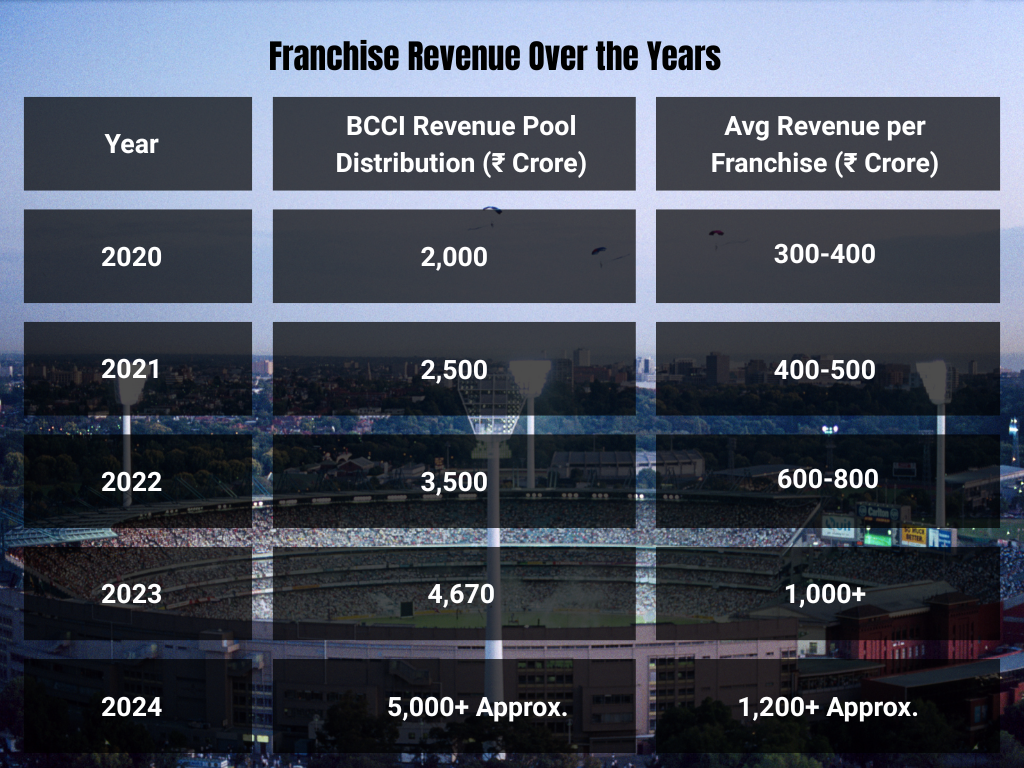The Indian Premier League (IPL) revenue streams have transformed cricket into a multi-billion-dollar business, making IPL one of the most profitable sports leagues in the world. Since its inception in 2008, IPL has leveraged its innovative business model to generate massive earnings through media rights, sponsorships, ticket sales, and franchise fees.

Over the past five years (2020-2024), the IPL’s financial growth has been remarkable, driven by skyrocketing broadcasting rights deals, lucrative sponsorships, and increased digital engagement. This case study explores how IPL makes money, breaking down its primary revenue streams, franchise earnings, and future growth opportunities.
IPL Revenue Streams: Where Does the Money Come From?
The IPL follows a multi-source revenue model, making it a financial powerhouse. The key components of its income include:
Media Rights – The Largest Contributor
- Broadcasting and digital streaming rights account for nearly 60-70% of IPL’s total revenue.
- Every 5 years, the IPL auctions its TV and digital streaming rights, securing multi-billion-dollar deals.
- The 2023-2027 cycle set a record-breaking deal of ₹48,390 crore ($6.2 billion), making IPL the second-most valuable league in the world (per match valuation).

Impact: The rise of digital streaming (JioCinema) has significantly increased IPL’s global viewership, attracting millions of new fans.
Sponsorships – A Key Revenue Driver
Sponsorship deals form the second-largest revenue source for the IPL.
- The title sponsorship for IPL is a highly competitive deal, with companies bidding for years of brand exposure.
- In 2022, Tata replaced Vivo as the title sponsor for ₹670 crore (2022-2023).
- Associate sponsorships with brands like Dream11, RuPay, and Upstox contributed over ₹1,485 crore in 2023.

Franchise Earnings & Revenue Distribution
IPL franchises earn revenue from multiple sources:
- Central Revenue Pool: 50% of IPL’s total earnings from media rights and sponsorships are distributed among franchises.
- Ticket Sales & Stadium Revenue: Home teams keep a share of the ticket sales, contributing 10-15% of a franchise’s total earnings.
- Merchandising & Licensing Deals: Team jerseys, caps, and partnerships with brands add additional revenue.

Ticket Sales & Stadium Revenue
IPL stadiums seat between 30,000-80,000 fans, generating significant match-day revenue.
- In 2022, ticket sales generated ₹500 crore.
- In 2023, post-COVID stadium occupancy increased, pushing ticket revenue to ₹600 crore.
Merchandising & Licensing
The IPL makes additional revenue through:
- Official team jerseys and fan merchandise, contributing ₹200-300 crore annually.
- Licensing agreements with Puma, Adidas, and Nike for team gear.
IPL Financial Growth (2020-2024)
The IPL’s revenue has grown 3X in the last five years, making it a dominant force in sports business.

How IPL Makes Money: Digital Growth & Advertising
- IPL 2023 final broke records with 32 million concurrent viewers on JioCinema.
- Total IPL 2023 viewership crossed 500 million+ unique users.
Advertising Boom
- IPL advertising rates in 2023 ranged from ₹15-20 lakh per 10 seconds.
- Brands like Tata, Cred, and Swiggy invested heavily in IPL ad slots.
Challenges & Future Growth Prospects
Challenges IPL Faces
- Player Fatigue & Injuries – Due to excessive matches.
- Competition from Other T20 Leagues – SA20, ILT20, and others.
- Saturation of Sponsorship Deals – Limited new brands entering.
Future Growth Opportunities
- Expansion to International Markets – Potential matches in USA & UAE.
- Increased Digital Innovation – AI-driven content & interactive fan engagement.
- Women’s Premier League (WPL) – Expected to add ₹2,000-3,000 crore annually.
Why the IPL’s Business Model is a Global Success
The Indian Premier League revenue streams have turned cricket into a multi-billion-dollar industry. With its multi-channel income strategy, record-breaking sponsorships, and massive digital viewership, IPL is poised for continued dominance in the sports world.
From 2020 to 2024, IPL’s revenue has grown over 300%, proving its resilience and financial power. As technology and fan engagement evolve, IPL is expected to set new benchmarks in sports business.
Leave a Reply